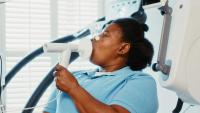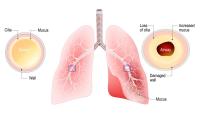Primary Ciliary Dyskinesia (PCD)
Make an Appointment
Our experienced team is here to help you learn more about our program, to schedule an appointment, or to help with a referral.
Primary Ciliary Dyskinesia (PCD) is a rare genetic disorder that leads to chronic ear, sinus, and lung infections and dysfunction that can cause bronchiectasis. NYP/CUIMC is an accredited PCD Foundation Clinical and Research Center site since 2023, in both adults and pediatrics. We provide comprehensive clinical care and participate in the PCD Patient Registry which provides access to information and research opportunities for people with PCD.
What Causes Primary Ciliary Dyskinesia (PCD)?
The airways in the sinuses and lungs are lined with minute, hairlike structures called cilia. As we inhale, we can breathe in dust, bacteria, and other small particles. The cilia move together in wavelike motions to carry mucus containing this foreign matter back toward the mouth, to be coughed or sneezed out of the body.
Some people are born with a genetic condition in which the cilia do not function properly, and are unable to move mucus up and out of the airways. In those with this rare condition, called primary ciliary dyskinesia (PCD), mucus accumulates in the airways and often leads to breathing problems and chronic, debilitating infections of the lungs, sinuses, and ears. Some people who have PCD have breathing problems from the moment of birth.
What Are the Symptoms of PCD?
The symptoms of PCD often overlap with those of other respiratory diseases, so diagnosing PCD early can be challenging, and many PCD patients are undiagnosed or misdiagnosed. Families may visit multiple specialists as they struggle to find an accurate diagnosis for. Below you'll find common features of PCD:
- Respiratory problems in newborns
- Chronic cough, usually present from birth or early infancy
- Excessive production of mucus and recurrent, debilitating lung infections
- Bronchiectasis, a condition when the airways are damaged, causing them to widen and become scarred
- Sinusitis, often severe and from an early age
- Frequent and severe ear congestion/infections, sometimes resulting in conductive hearing loss
- Laterality defects organ placement and structure, including situs inversus (total reversal of organs)


